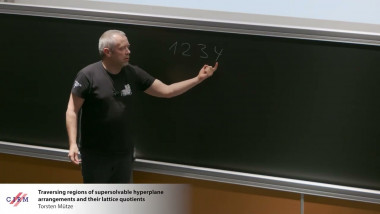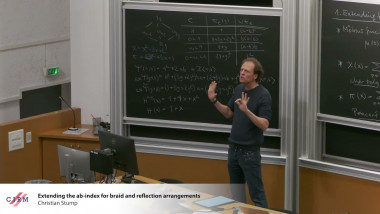
Traversing regions of supersolvable hyperplane arrangements and their lattice quotients
De Torsten Mütze

Extending the ab-index for braid and reflection arrangements
De Christian Stump
Apparaît dans la collection : Multidimensional symbolic dynamics and lattice models of quasicrystals / Dynamique symbolique multidimensionnelle et modèles de quasi-cristaux sur réseau
For every positive integer $n$, we introduce a set $\mathcal{T}_n$ made of $(n+3)^2$ Wang tiles (unit squares with labeled edges). We represent a tiling by translates of these tiles as a configuration $\mathbb{Z}^2 \rightarrow \mathcal{T}_n$. A configuration is valid if the common edge of adjacent tiles has the same label. For every $n \geqslant 1$, we consider the Wang shift $\Omega_n$ defined as the set of valid configurations over the tiles $\mathcal{T}_n$. The family $\left\{\Omega_n\right}_{n \geqslant 1}$ broadens the relation between quadratic integers and aperiodic tilings beyond the omnipresent golden ratio as the dynamics of $\Omega_n$ involves the positive root $\beta$ of the polynomial $x^2-n x-1$. This root is sometimes called the $n$-th metallic mean, and in particular, the golden mean when $n=1$ and the silver mean when $n=2$. The family gathers the hallmarks of other small aperiodic sets of Wang tiles. When $n=1$, the set of Wang tiles $\mathcal{T}_1$ is equivalent to the Ammann aperiodic set of 16 Wang tiles. The tiles in $\mathcal{T}_n$ satisfy additive versions of equations verified by the Kari-Culik aperiodic sets of 14 and 13 Wang tiles. Also configurations in $\Omega_n$ are the codings of a $\mathbb{Z}^2$-action on a 2-dimensional torus by a polygonal partition like the Jeandel-Rao aperiodic set of 11 Wang tiles. The tiles can be defined as the different instances of a square shape computer chip whose inputs and outputs are 3-dimensional integer vectors. There is an almost one-to-one factor map $\Omega_n \rightarrow \mathbb{T}^2$ which commutes the shift action on $\Omega_n$ with horizontal and vertical translations by $\beta$ on $\mathbb{T}^2$. The factor map can be explicitely defined by the average of the top labels from the same row of tiles as in Kari and Culik examples. We also show that $\Omega_n$ is self-similar, aperiodic and minimal for the shift action. Also, there exists a polygonal partition of $\mathbb{T}^2$ which we show is a Markov partition for the toral $\mathbb{Z}^2$-action. The partition and the sets of Wang tiles are symmetric which makes them, like Penrose tilings, worthy of investigation. Details can be found in the preprints available at https://arxiv.org/abs/ 2312.03652 (part I) and https://arxiv.org/abs/2403. 03197 (part II). The talk will present an overview of the main results.
